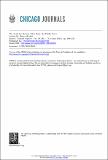The Arab Revolution Takes Back the Public Space
Author(s)
Rabbat, Nasser
DownloadRabbat_The Arab.pdf (177.7Kb)
PUBLISHER_POLICY
Publisher Policy
Article is made available in accordance with the publisher's policy and may be subject to US copyright law. Please refer to the publisher's site for terms of use.
Terms of use
Metadata
Show full item recordAbstract
In 1991, al-Sadiq al-Nayhum, a Libyan thinker exiled in Geneva, published a book of collected essays in Arabic with the provocative title Islam in Captivity: Who Stole the Mosque and Where Did Friday Disappear?2 The thesis of the book was not novel. Al-Nayhum posited that modernity had failed to take root in the Arab world because in large part it had grown out of Western history and developed in a Western cultural and epistemological context, which is incompatible with the culture and knowledge nurtured by Islam. Al-Nayhum, predictably, advocated a return to a pure, foundational Islam to rebuild the battered and confused Arab societies.
Date issued
2012-09Department
Massachusetts Institute of Technology. Department of ArchitectureJournal
Critical Inquiry
Publisher
University of Chicago Press
Citation
Rabbat, Nasser. “The Arab Revolution Takes Back the Public Space.” Critical Inquiry 39, no. 1 (September 2012): 198-208. © 2012 by The University of Chicago.
Version: Final published version
ISSN
00931896
15397858